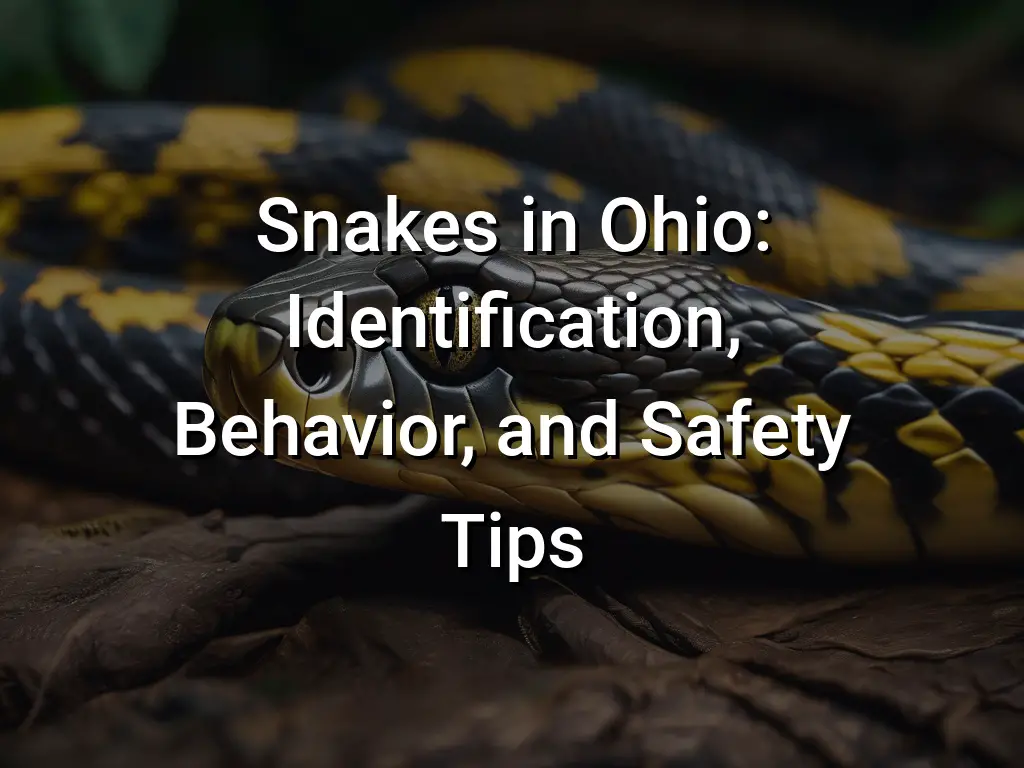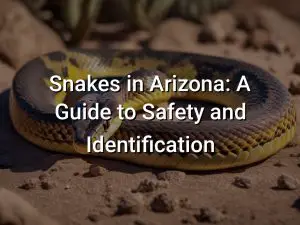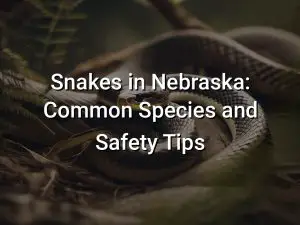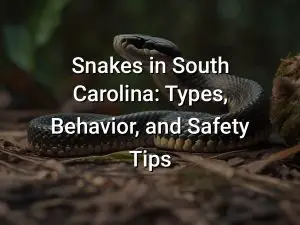Snakes in Ohio: Identification, Behavior, and Safety Tips

Snakes in Ohio can be both fascinating and intimidating creatures. With their diverse species and intriguing behavior, they play an important role in the ecosystem. In this article, we will explore the common snakes found in Ohio, providing valuable information about their identification, behavior, and most importantly, safety tips for dealing with them.
From the strikingly colored Eastern Massasauga Rattlesnake to the secretive and docile Eastern Garter Snake, Ohio is home to a variety of snake species. We will delve into the characteristics that can help you identify these snakes and understand their unique behaviors. Additionally, we will provide important safety tips to ensure you can safely coexist with these reptiles in their natural habitat. So, if you’re curious about the snakes of Ohio or want to be prepared for any encounters, read on for a comprehensive guide!
Quick Links
Common Snakes in Ohio
Ohio is home to a diverse range of snake species, many of which are harmless and play a beneficial role in the ecosystem. Here are some of the common snakes that can be found in Ohio:
- Eastern Garter Snake: This snake is one of the most common snake species in Ohio and can be found in a variety of habitats, including forests, fields, and wetlands. It is non-venomous and typically has yellow or greenish stripes running down its body.
- Northern Water Snake: As its name suggests, this snake is often found near bodies of water, such as rivers, lakes, and ponds. It is non-venomous and has a dark brown or black body with distinctive reddish-brown blotches.
- Eastern Rat Snake: Also known as the black rat snake, this species is non-venomous and can grow quite large, reaching lengths of up to 6 feet or more. It has a black body with a white or yellow underside.
- Eastern Milk Snake: This snake gets its name from its habit of entering barns and other buildings in search of mice and other small rodents. It is non-venomous and has a distinctive pattern of reddish-brown or black blotches on a light gray or tan background.
While encountering a snake in Ohio is not uncommon, it’s important to remember that most snakes are not a threat to humans if left undisturbed. It is always best to give snakes their space and appreciate them from a safe distance.
Identification of Ohio Snakes
Ohio is home to a variety of snake species, some of which are venomous and pose potential risks to humans. It is important to be able to identify the different snake species found in Ohio to ensure your safety. Here are some common snakes you may encounter:
- Northern Watersnake: These non-venomous snakes are commonly found near bodies of water. They have dark-colored bands on their bodies and a light-colored belly.
- Eastern Gartersnake: Gartersnakes are non-venomous and have a distinctive three-striped pattern on their bodies. They are usually found in grassy areas or gardens.
- Eastern Milksnake: Milksnakes are non-venomous and have a pattern of red or brown blotches on a light-colored background. They are commonly found in woodland areas.
- Northern Copperhead: Copperheads are venomous snakes with copper-colored heads and hourglass-shaped bands on their bodies. They are usually found in wooded areas.
- Eastern Massasauga: Massasaugas are venomous snakes with a rattlesnake-like appearance. They are gray or light brown with dark blotches on their bodies and are found in wetland areas.
If you encounter a snake and are unsure of its species, it is best to keep your distance and contact a professional for assistance with identification.
Behavior of Ohio Snakes
Ohio is home to a variety of snake species, each with its own unique behaviors and characteristics. While snakes may inspire fear in some people, it’s important to understand their behavior in order to coexist safely with these creatures. Here are some key aspects of Ohio snake behavior:
- Habitat: Snakes in Ohio can be found in a range of habitats, including forests, wetlands, fields, and even suburban areas. They seek out environments that provide shelter, food, and suitable temperatures.
- Activity Patterns: Many snakes in Ohio are primarily active during the warmer months, from April to October, when they bask in the sun to regulate their body temperature. They are more likely to be active during the day, but some species, like the Eastern Massasauga rattlesnake, may also be active at night.
- Feeding Habits: Snakes are carnivorous and feed on a variety of prey, including rodents, birds, amphibians, and other small animals. They use their venom or constriction to subdue and capture their prey before swallowing it whole.
- Reproduction: Ohio snakes typically mate in the spring, and females may give birth to live young or lay eggs, depending on the species. They exhibit different mating behaviors and breeding strategies, such as courtship displays and male combat.
- Defense Mechanisms: When threatened, snakes in Ohio may exhibit defensive behaviors to protect themselves. Some may try to flee, while others may try to intimidate predators by hissing, coiling, or displaying their fangs. It’s important to give snakes their space and avoid provoking them.
- Hibernation: During the colder months, many Ohio snakes hibernate in underground burrows, rock crevices, or other shelters to survive the winter. They may gather together in communal hibernation sites, known as hibernacula.
Understanding the behavior of snakes in Ohio can help to reduce misunderstandings and promote coexistence. If you encounter a snake in your area, it’s best to keep a safe distance and appreciate it from afar. If you’re unsure of the species or need assistance, it’s recommended to contact a local wildlife expert for guidance.
Safety Tips for Dealing with Ohio Snakes
While encountering snakes in Ohio is not uncommon, it is important to remember that most snakes are harmless and play a beneficial role in the ecosystem. However, it is still wise to take precautions to ensure your safety when dealing with snakes. Here are some safety tips to keep in mind:
- Stay calm: If you encounter a snake, try to remain calm and avoid startling or provoking it. Most snake bites occur when people try to handle or kill snakes.
- Keep your distance: To minimize the chance of a snake bite, always maintain a safe distance from the snake. Snakes have a striking distance that can range from half their body length to their full body length.
- Identify venomous snakes: Familiarize yourself with the venomous snakes in your area. In Ohio, venomous snakes include the Eastern Massasauga Rattlesnake and the Northern Copperhead. These snakes have distinct markings and behaviors that can help you identify them.
- Wear protective clothing: When exploring areas where snakes may be present, wear long pants, long-sleeved shirts, and closed-toe shoes. This will provide a layer of protection in case of accidental contact with a snake.
- Watch where you step and reach: When walking in natural areas, be mindful of where you step and where you place your hands. Avoid stepping over logs or rocks without first checking for snakes hiding underneath.
- Use caution near water: Snakes are often found near bodies of water, so be cautious when swimming or boating. Avoid reaching into areas where you cannot see, such as under docks or overgrown vegetation.
- Don’t disturb snake habitats: Snakes play an important role in the ecosystem, so avoid disrupting their habitats. Do not remove logs, rocks, or other forms of cover that snakes may be using.
- If bitten, seek medical attention: In the event of a snake bite, seek immediate medical attention. Do not attempt to treat the bite yourself or use any home remedies.
By following these safety tips, you can minimize the risk of encounters with snakes and ensure your own safety and the safety of the snakes.
Conclusion
By familiarizing yourself with the common snakes in Ohio, their identification, behavior, and safety tips, you can better understand and coexist with these reptiles in your surroundings. Remember, snakes play an important role in the ecosystem, controlling pests and maintaining the balance of the natural environment.
While encountering a snake may be alarming, practicing caution and following safety tips can help ensure your safety and the snake’s well-being. If you have concerns or encounter a snake that you cannot identify or handle safely, it’s best to contact a professional for assistance. By respecting these creatures and arming yourself with knowledge, you can peacefully coexist with snakes in Ohio.







